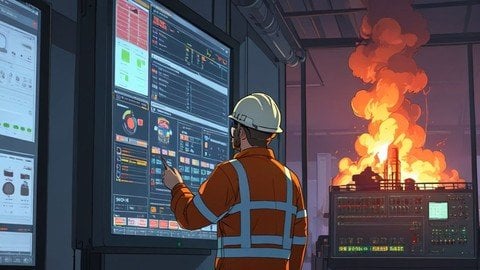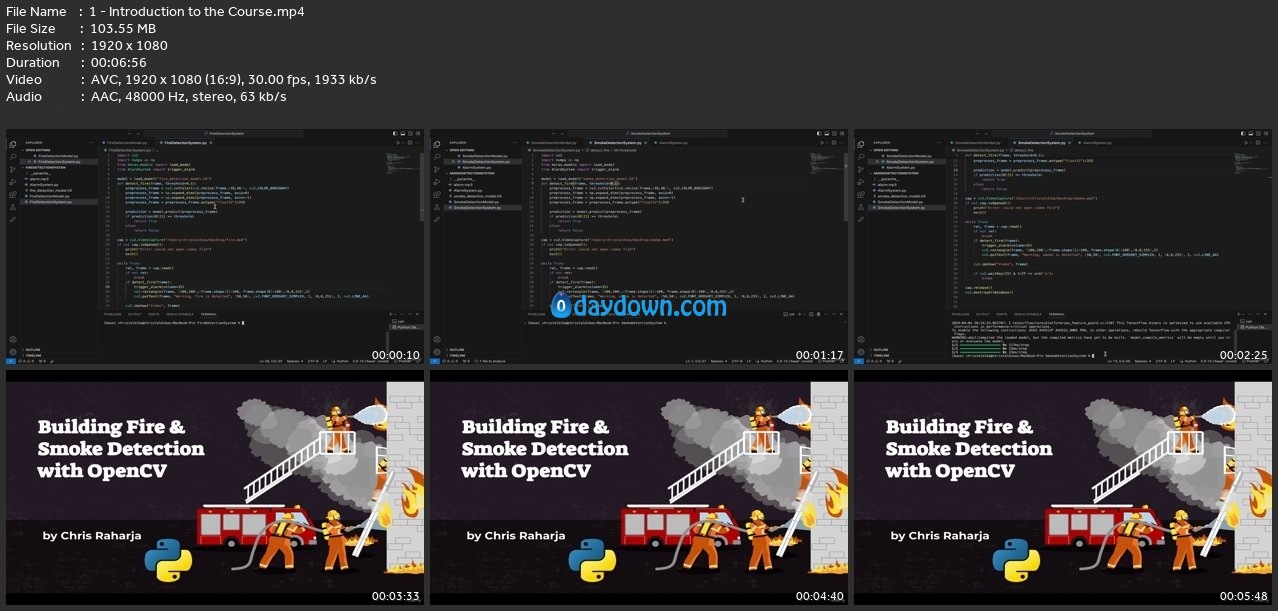
Published 4/2024
MP4 | Video: h264, 1920×1080 | Audio: AAC, 44.1 KHz
Language: English | Size: 1.37 GB | Duration: 2h 15m
Learn how to build fire and smoke detection systems using OpenCV, Keras, and Convolutional Neural Networks
What you’ll learn
Learn how to build fire detection system using OpenCV
Learn how to train fire detection model using Keras and Convolutional Neural Network
Learn how to build smoke detection system using OpenCV
Learn how to train smoke detection system using Keras and Convolutional Neural Network
Learn how to create alarm using gTTS
Learn how to integrate alarm to fire & smoke detection systems and make it ring whenever fire or smoke is detected
Learn the basic fundamentals of fire and smoke detection system, such as getting to know its use cases, technical limitation, and technologies that will be used
Learn how fire and smoke detection systems work. This section will cover data collection, data preprocessing, model training, model deployment, output detection
Learn how to open webcam using OpenCV
Learn how to play video using OpenCV
Learn how to find and download fire and smoke dataset from Kaggle
Learn how to conduct performance testing on fire and smoke detection systems
Requirements
No previous experience in object detection is required
Basic knowledge in Python
Description
Welcome to Building Fire & Smoke Detection with OpenCV course. This is a comprehensive project based course where you will learn step by step on how to build a fire and smoke detection system using OpenCV, Keras, and convolutional neural networks. The detection system will also be equipped with an alarm that will ring whenever fire or smoke is detected. This course is a perfect combination between object detection and computer vision, making it an ideal opportunity to practice your programming skills by building projects with real world applications. In the introduction session, you will learn the basic fundamentals of a fire and smoke detection system, such as getting to know its use cases, technologies that will be used, and some technical challenges. Then, in the next session, you will learn how fire and smoke detection systems work. This section will cover data collection, preprocessing, model training, model deployment, and fire or smoke detection. Before starting the project, we will download fire and smoke datasets from Kaggle, the data will contain hundreds or even thousands of images where fire or smoke present, we will use those data to train our detection model. Once everything is ready, we will enter the project section. In the first section, you will be guided step by step on how to build a fire detection system using OpenCV and Keras. Then, in the second project section, you will build a smoke detection system using OpenCV and convolutional neural networks. Once those detection systems have been built, we will also create a notification system to alert people whenever fire or smoke is detected, to make it even more complete, we will integrate an alarm system that will go off as soon as fire or smoke is detected. Even more exciting, we will use a text to speech library to create customized sound for the alarm. Finally, at the end of the course, we will be conducting testing on the fire and smoke detection system. There will be two testing objectives that we will be mainly focusing on, those are performance testing where we will evaluate the efficiency and accuracy of the fire and smoke detection system under different conditions and alarm testing where we will assess the reliability and effectiveness of the alarm system in promptly alerting users to potential fire or smoke incidents.First of all, before getting into the course, we need to ask ourselves this question: why should we build a fire and smoke detection system? Well, here is my answer: Fire and smoke detection systems are critical for safeguarding lives and property, as they provide early warnings of potential hazards, allowing for timely evacuation and intervention. Additionally, these systems can help mitigate the devastating effects of fires by enabling prompt response and containment measures. Moreover, in environments where human monitoring is impractical or hazardous, such as industrial facilities or remote areas, automated fire and smoke detection systems are indispensable for ensuring safety and security. Furthermore, by developing our own fire and smoke detection system, we gain valuable insights into the underlying principles of computer vision and machine learning, empowering us to tackle a wide range of real-world challenges in this field.Below are things that we can expect to learn from this course:Learn the basic fundamentals of fire and smoke detection system, such as getting to know its use cases, technical limitations, and technologies that will be usedLearn how fire and smoke detection systems work. This section will cover data collection, data preprocessing, data labelling, model training, model deployment, and output detectionLearn how to open webcam using OpenCVLearn how to play video using OpenCVLearn how to find and download fire and smoke dataset from KaggleLearn how to build fire detection system using OpenCVLearn how to train fire detection model using Keras and Convolutional Neural NetworkLearn how to build smoke detection system using OpenCVLearn how to train smoke detection system using Keras and Convolutional Neural NetworkLearn how to create alarm using gTTSLearn how to integrate alarm to fire & smoke detection systems and make it ring whenever fire or smoke is detectedLearn how to conduct performance testing on fire and smoke detection systems
Overview
Section 1: Introduction
Lecture 1 Introduction to the Course
Lecture 2 Table of Contents
Lecture 3 Whom This Course is Intended for?
Section 2: Tools, IDE, and Datasets
Lecture 4 Tools, IDE, and Datasets
Section 3: Introduction to Fire & Smoke Detection Systems
Lecture 5 Introduction to Fire & Smoke Detection Systems
Section 4: How Fire & Smoke Detection Systems Work?
Lecture 6 How Fire & Smoke Detection Systems Work?
Section 5: Installing OpenCV, Numpy, and Keras
Lecture 7 Installing OpenCV, Numpy, and Keras
Section 6: Opening Webcam Using OpenCV
Lecture 8 Opening Webcam Using OpenCV
Section 7: Playing Video Using OpenCV
Lecture 9 Playing Video Using OpenCV
Section 8: Finding & Downloading Fire Dataset From Kaggle
Lecture 10 Finding & Downloading Fire Dataset From Kaggle
Section 9: Training Fire Detection Model with Keras & Convolutional Neural Network
Lecture 11 Training Fire Detection Model with Keras & Convolutional Neural Network
Section 10: Building Fire Detection System with OpenCV
Lecture 12 Building Fire Detection System with OpenCV
Section 11: Testing Fire Detection System
Lecture 13 Testing Fire Detection System
Section 12: Finding & Downloading Smoke Dataset From Kaggle
Lecture 14 Finding & Downloading Smoke Dataset From Kaggle
Section 13: Training Smoke Detection Model with Keras & Convolutional Neural Network
Lecture 15 Training Smoke Detection Model with Keras & Convolutional Neural Network
Section 14: Building Smoke Detection System with OpenCV
Lecture 16 Building Smoke Detection System with OpenCV
Section 15: Testing Smoke Detection System
Lecture 17 Testing Smoke Detection System
Section 16: Creating Alarm with gTTS
Lecture 18 Creating Alarm with gTTS
Section 17: Integrating Alarm to Fire Detection System
Lecture 19 Integrating Alarm to Fire Detection System
Section 18: Integrating Alarm to Smoke Detection System
Lecture 20 Integrating Alarm to Smoke Detection System
Section 19: Conclusion & Summary
Lecture 21 Conclusion & Summary
People who are interested in building fire and smoke detection systems using OpenCV, Keras, and Convolutional Neural Network,People who are interested in creating alarm using gTTS and integrate it to the fire and smoke detection systems
转载请注明:0daytown » Building Fire & Smoke Detection With Opencv, Keras, And Cnn
 Password/解压密码www.tbtos.com
Password/解压密码www.tbtos.com